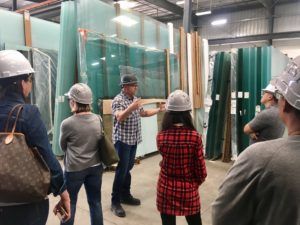
I was lucky enough last week to be part of a group given a tour of the Pulp Studio facility, located in Gardena, California. The group was comprised jointly of several Giroux Glass employees, as well as women who expressed an interest to attend through the Los Angeles chapter of NAWIC (National Association of Women in Construction), as one of many interesting site visits they arrange for members. This plant certainly met the criteria for interesting as well as educational.
Our patient hosts and guides were Kirk Johnson, director of plant operations, and Cathy Yamasaki, sales associate. Together they toured us through the plant which measures just under 180,000 square feet and employs 125 people, who work six days a week. It’s also a highly energy efficient and ecologically-oriented facility; they generate no grey water that they don’t reuse themselves, and recycle all of their unwanted glass.
I discovered a few things that I’d never heard before. In viewing the area in which custom paint colors are mixed and applied to glass, we were told that not only can Pulp reproduce any color a client requests, but also that painted glass can be recycled along with other types of glass to ultimately become clear again. Such alchemy was news to me.
I learned about the process is to chemically temper glass, and what the benefits are of using such treated glass. The cost is a little higher than the cost of regular, tempered glass, but the end product is scratch-resistant, unbreakable, more graffiti resistant. Another benefit is that it enables bent glass to be chemically strengthened, and allows smaller glass thicknesses to be processed than those required for tempered glass. We saw the over-sized tank Pulp uses to chemically process glass. Pulp claims it’s the biggest chemical tank in North America, and I could easily see why.
Another interesting feature of this plant is that it ran counterclockwise to what I’ve noticed in other manufacturing plants. In most cases, the process begins at one end, closest to the front of the building, and the products work the way towards the back, where ultimately, they get loaded onto trucks for shipping. In this plant, the product works its way towards the front of the building, towards where the management team’s offices are located, to facilitate more frequent and convenient quick inspections before products leave the premises.
It seems to be working well for Pulp. From the moment we entered their conference room and lobby area, we could see that their specialty is the unusual and highly decorative. The lobby and conference area were very attractive, with walls of glass that served several purposes.
They’re busy with projects that will send their glass all over the country and the world. A good percentage of product Pulp fabricates is for projects outside of California. And, like Giroux Glass, they consider their sweet spot is for those projects considered by most to “the most challenging”– those for which the greatest amount of ingenuity and creativity is required. I was happy to see how Pulp does the work that they do, and will be all the more eager to see our field guys installing it in design-forward buildings in Southern California and Nevada.






Blog